The Sagrada Família Passion façade remembers Jesus final days, from the Last Supper to his Resurrection.
Antoni Gaudí’s plans
In 1911, Antoni Gaudí fell ill and had to move to Puigcerdà, a town in the Pyrenees, to recover in a healthier environment than the industrial Barcelona of that time. During this forced convalescence, Gaudí felt he was on death’s door (he even drew up his will), which along with his reading of Saint John of the Cross, inspired him to design the Passion façade. The result was various sketches the architect drew in 1:200 scale, which were used as inspiration when work began on the façade in 1954.
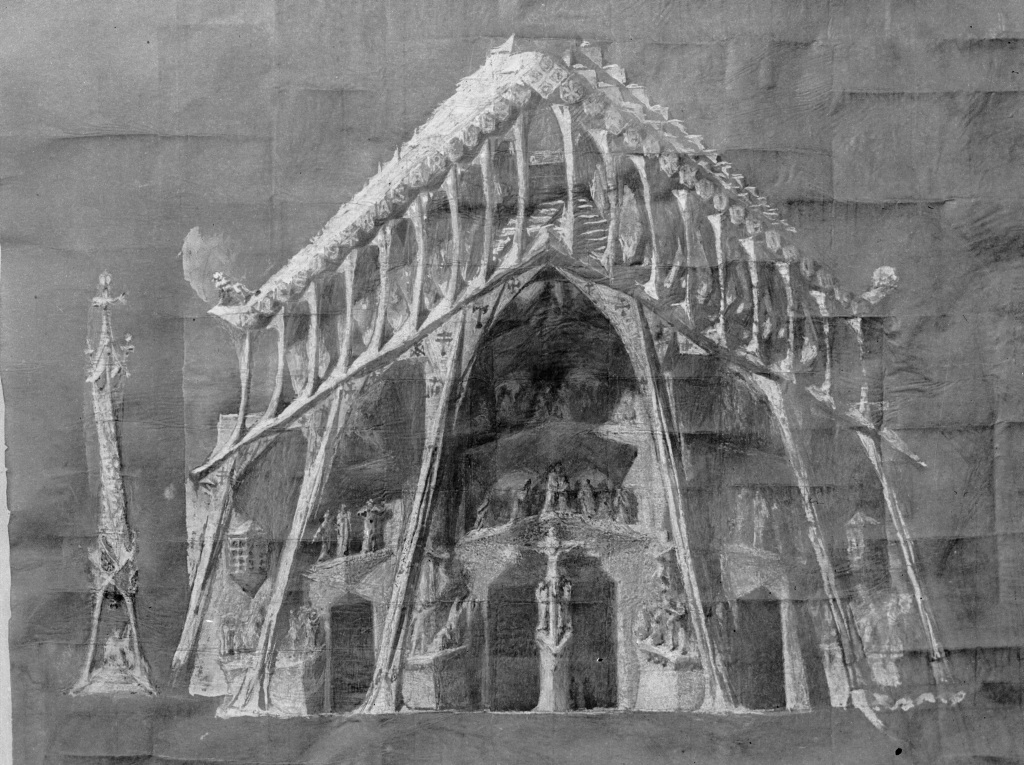
Original drawing of the narthex on the Passion façade, published in El Propagador in 1917. Credit: Antoni Gaudí El Propagador el 1917. Autor: Antoni Gaudí
In stark contrast to the joy of the Birth and the explosion of life on the Nativity façade (with flowers, birds, soft, rounded shapes, the drops and snow), Gaudí explicitly indicated that this façade should be “harsh and cruel, as if made of bones”.
Isidre Puig i Boada explained what this façade should look like in 'El pensament de Gaudí':
«Some may find this façade too extravagant. But I wanted it to inspire fear, and to do so I used plenty of chiaroscuro, recesses and protrusions, all of which gives it an extremely gloomy effect. What’s more, I’m willing to sacrifice the building itself, to break arches, cut down columns, in order to give people an idea of how bloody the sacrifice is.»
Isidre Puig i Boada - El pensament de Gaudí. Page 200
Evangelical meaning of the façade
Jesus Christ’s final days and Passion are presented chronologically on the lower narthex of the façade, in a journey on three levels that begins at the bottom left and carries on upwards in an S-shaped path. Further up, on the pediment, we see the Resurrection, culminating on the top level with the Ascension to Heaven (see infographic).
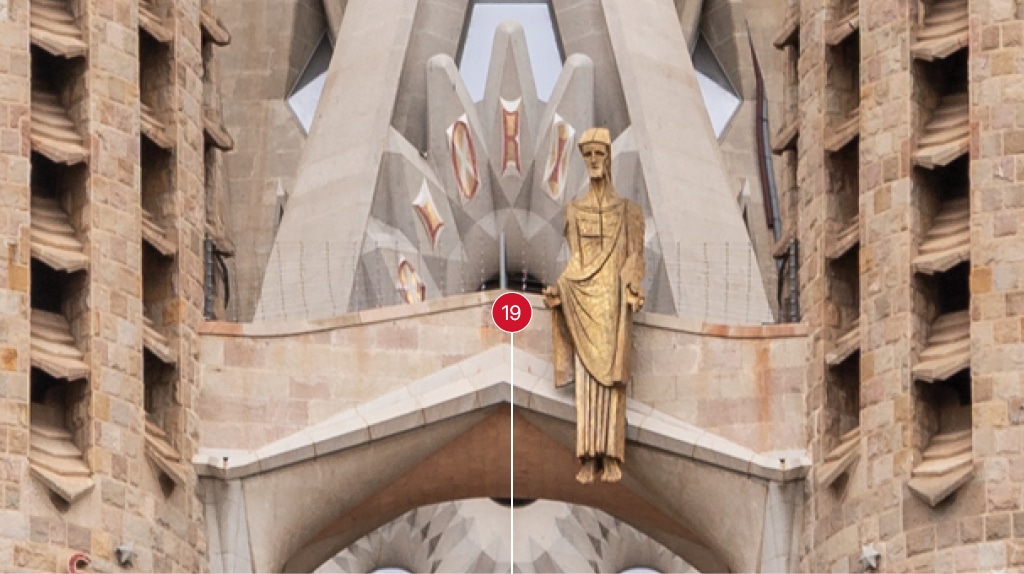
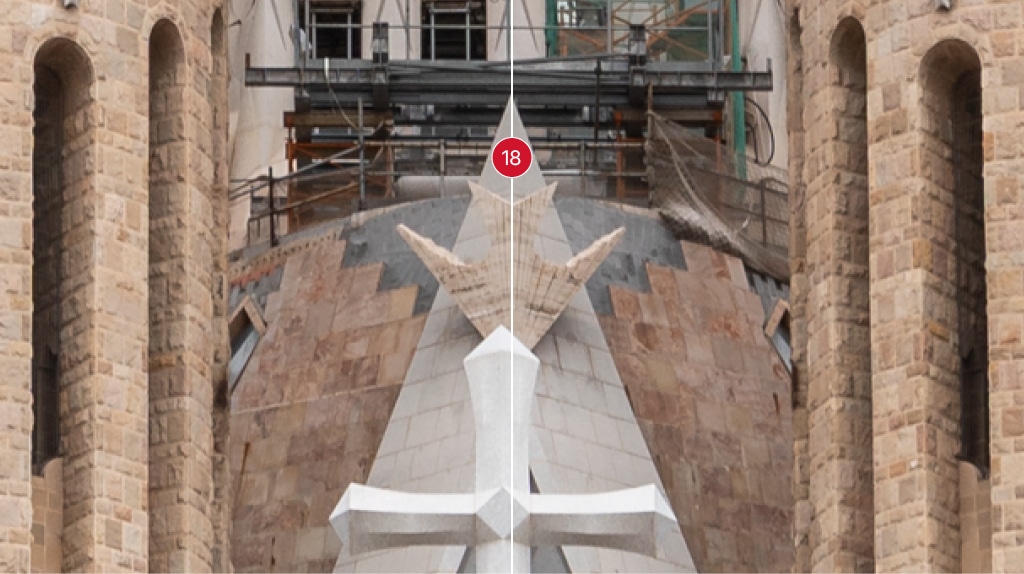
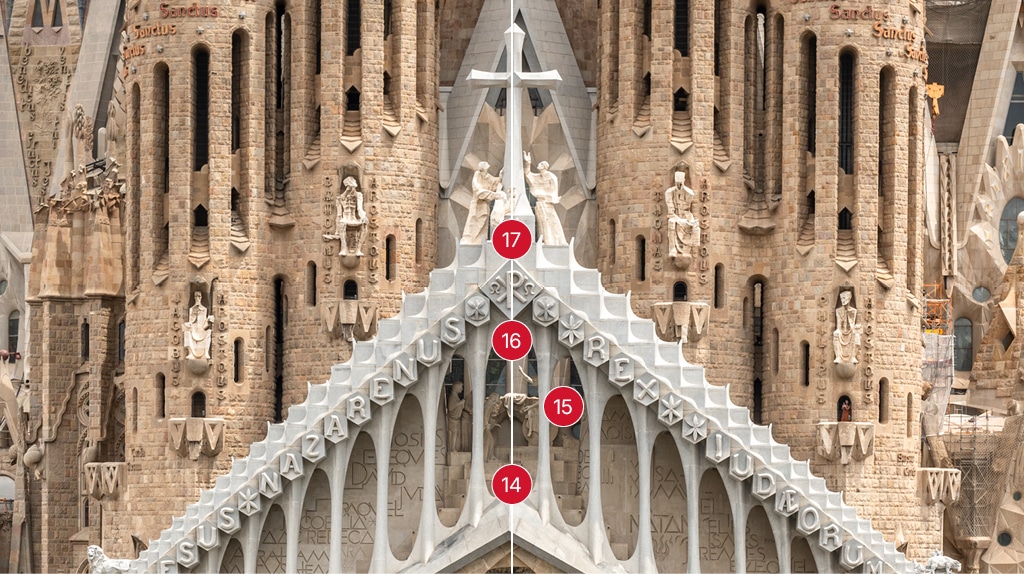
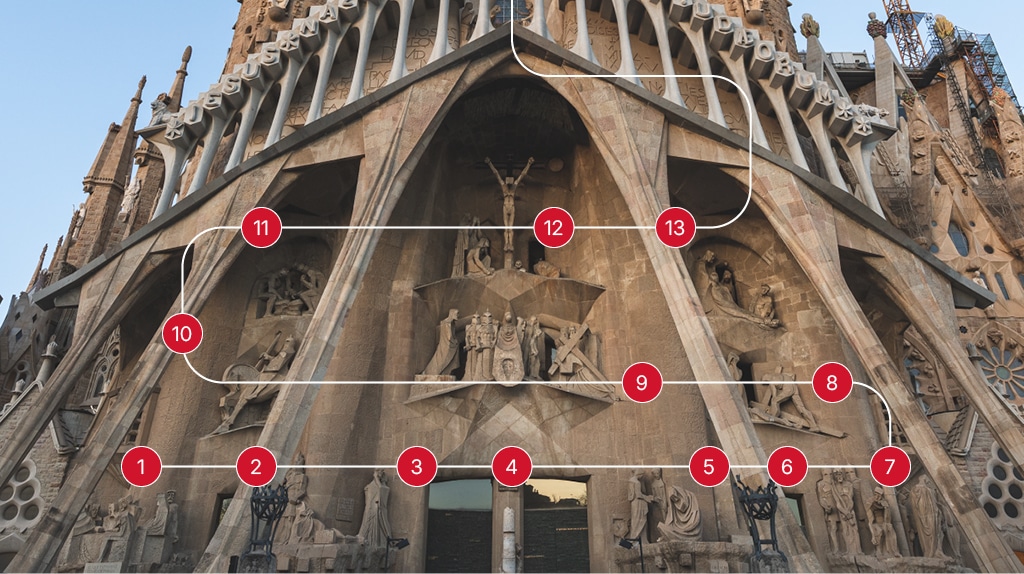
Sculpture groups on the lower narthex: key works of Josep Maria Subirachs
After spending a year studying Gaudí’s drawings, sculptor Josep Maria Subirachs, who passed eleven years ago this 7 April, was chosen to carve the 12 sculpture groups for the Passion façade. For some time, Subirachs lived in a modest room at the Basilica and dedicated himself fully to his work, just as Gaudí did towards the end of his life. The figures, in travertine and Floresta sandstone, feature hard, severe lines, at times Brutalist and at others soft, expressing the coarse, even gloomy effect that Gaudí wanted to represent the pain of the Passion and death.

Josep Maria Subirachs (Barcelona, 1927–2014): was a sculptor, illustrator and engraver. From a Noucentisme style, he evolved towards Expressionism through sharp, angular shapes and exaggerated volumes, which his work is known for. He created the first abstract sculptures displayed in public in Barcelona including the tribute to Francesc Macià in Plaça de Catalunya, and devoted himself exclusively to his work on the Sagrada Família from 1986.
1. The Last Supper
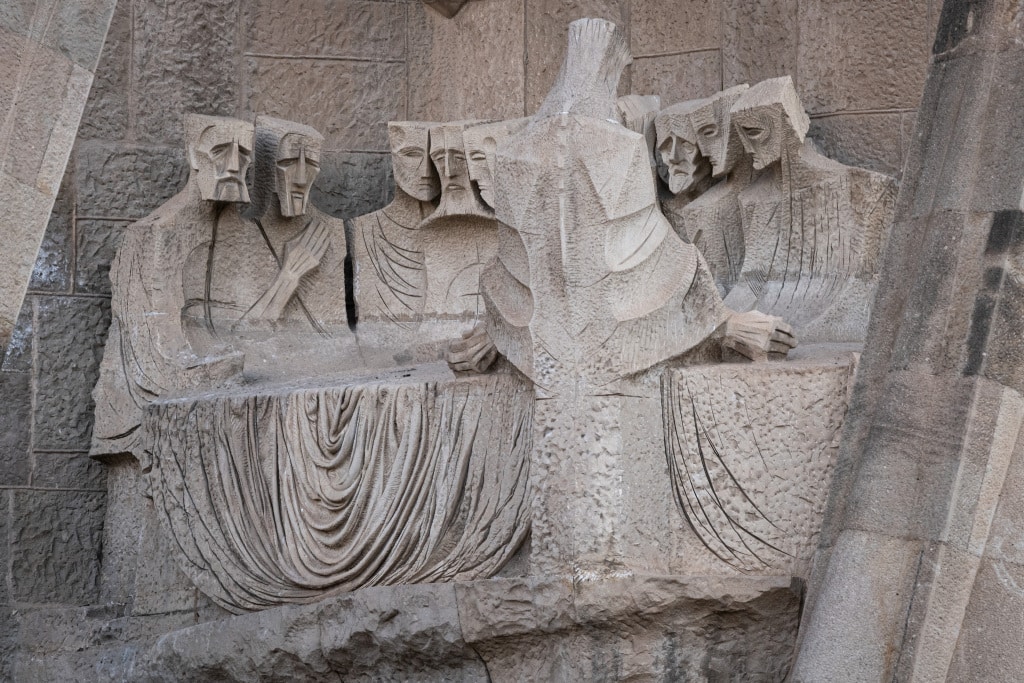
2. Arrest of Jesus
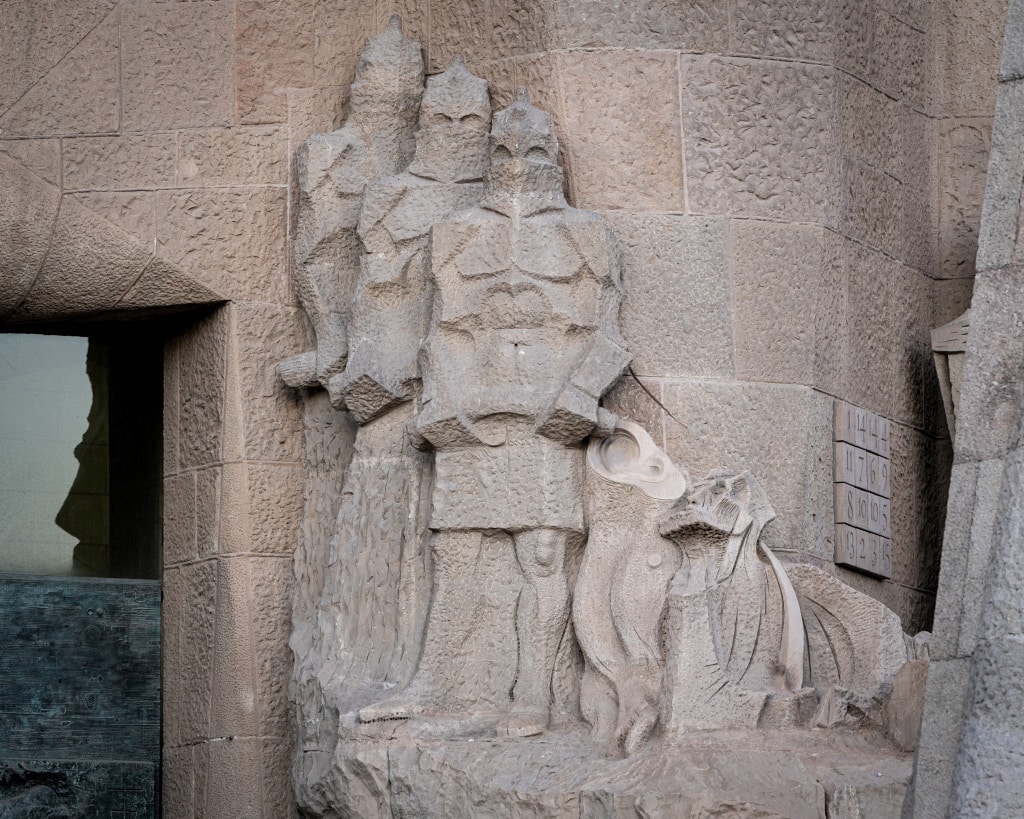
A group of armed men go in search of Jesus. In the struggle to keep him from being taken, the apostle Peter cuts off the right ear of the high priest’s servant, which one of the soldiers has in his hand. Subirachs carving on the figures in this group is less clear, suggesting the scene took place at night.
3. Betrayal of Judas
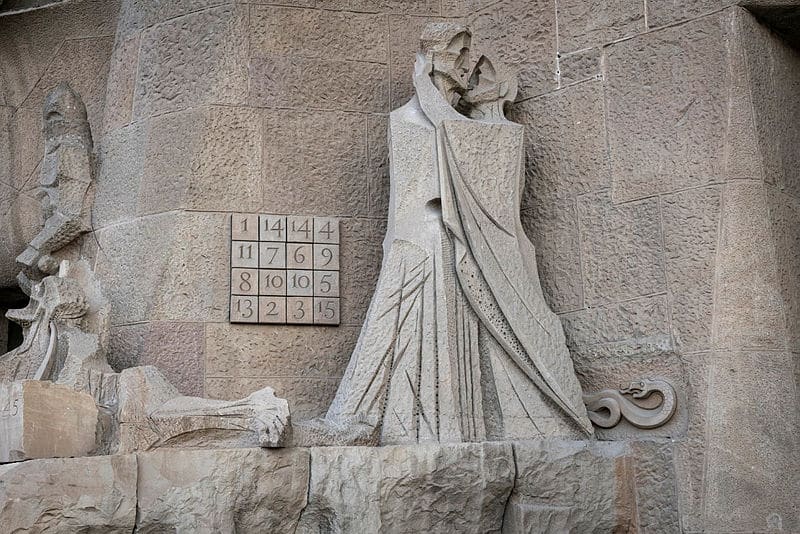
Judas hugs Jesus and kisses him to signal to the soldiers who to arrest. At the apostle’s feet there is a snake, a reptile that represents earthly imperfection and the lower passions, here a symbol of evil in Judas’ betrayal.
4. The flagellation
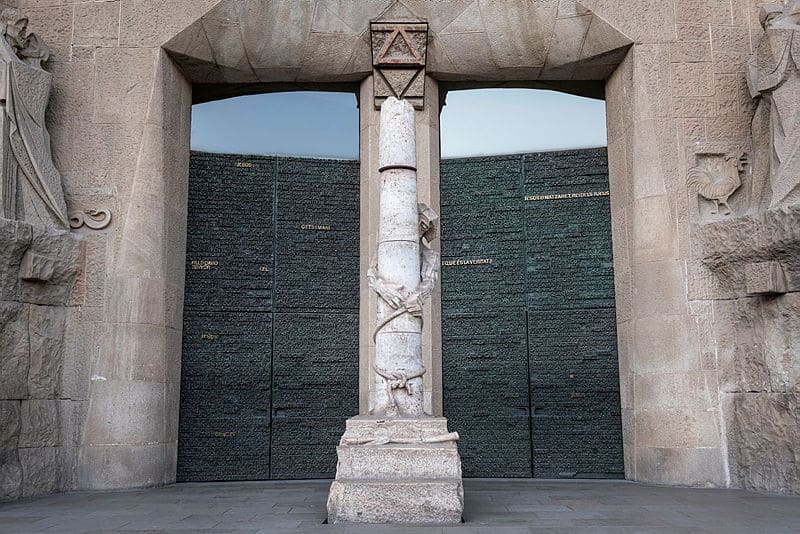
Five metres tall, this sculpture group stands between the two main doors on this façade. It expresses the suffering and solitude of Jesus, who stands between Judas, who betrayed him, and Peter, who denied him three times.
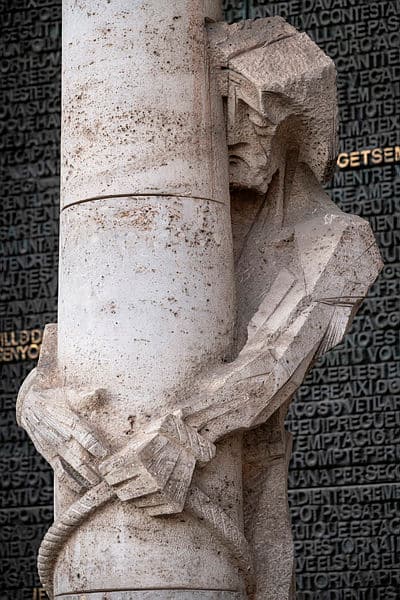
5. Peter's denial
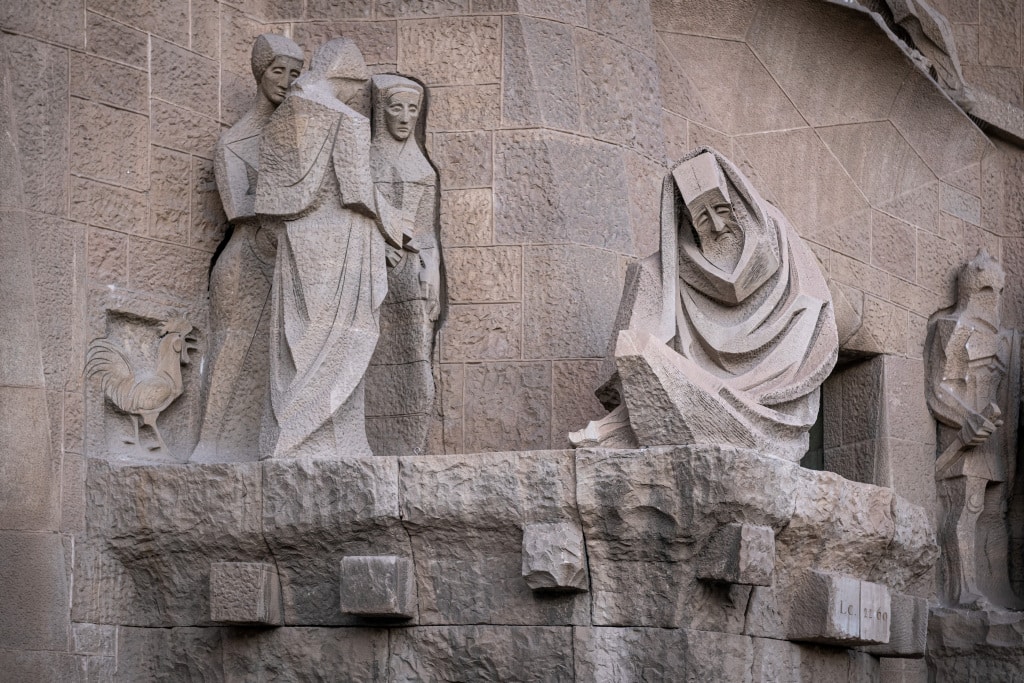
Peter’s body language and facial expression show his shame for having denied his master three times. The apostle is shown wrapped in a sheet and three women stand next to him, representing the three denials. One of them points to him to signal that he is one of Jesus’ disciples. Next to the women is a rooster. “Truly I say to you, today, this very night, before the cock crows twice, you will deny me three times” (Mk 14:30).
6. The Ecce Homo (“behold the man”)
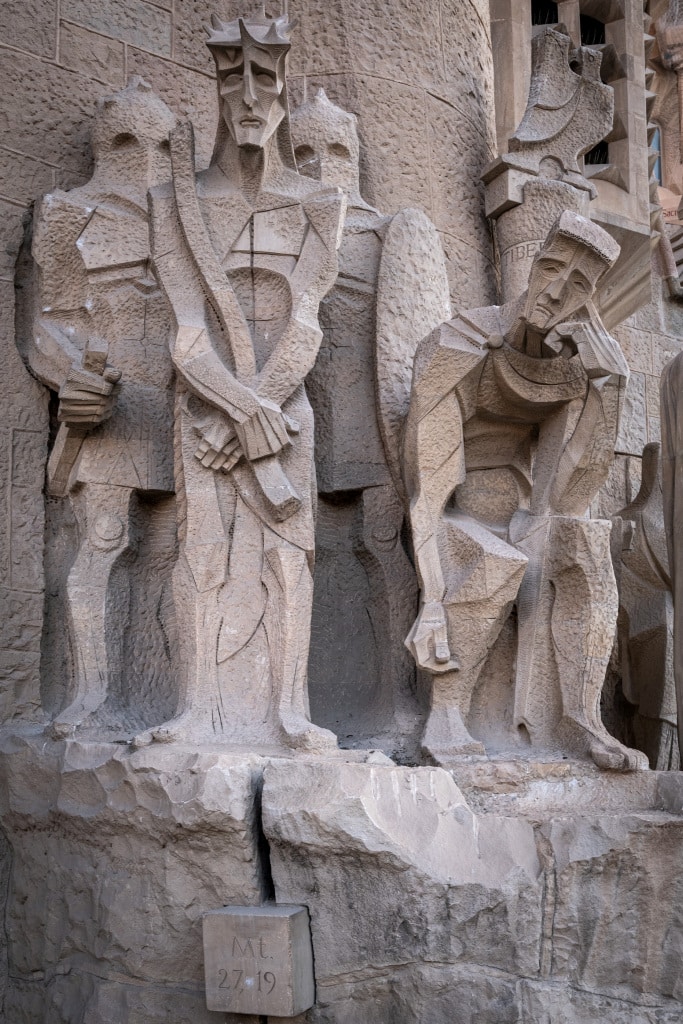
These are the words Pontius Pilate pronounced when publicly presenting Jesus, who is shown with the crown of thorns after being beaten. The Roman governor is seated, deep in thought, struggling with the decision he has to make. Under Jesus’ feet, the stone is cracking.
7. The judgement of Pilate
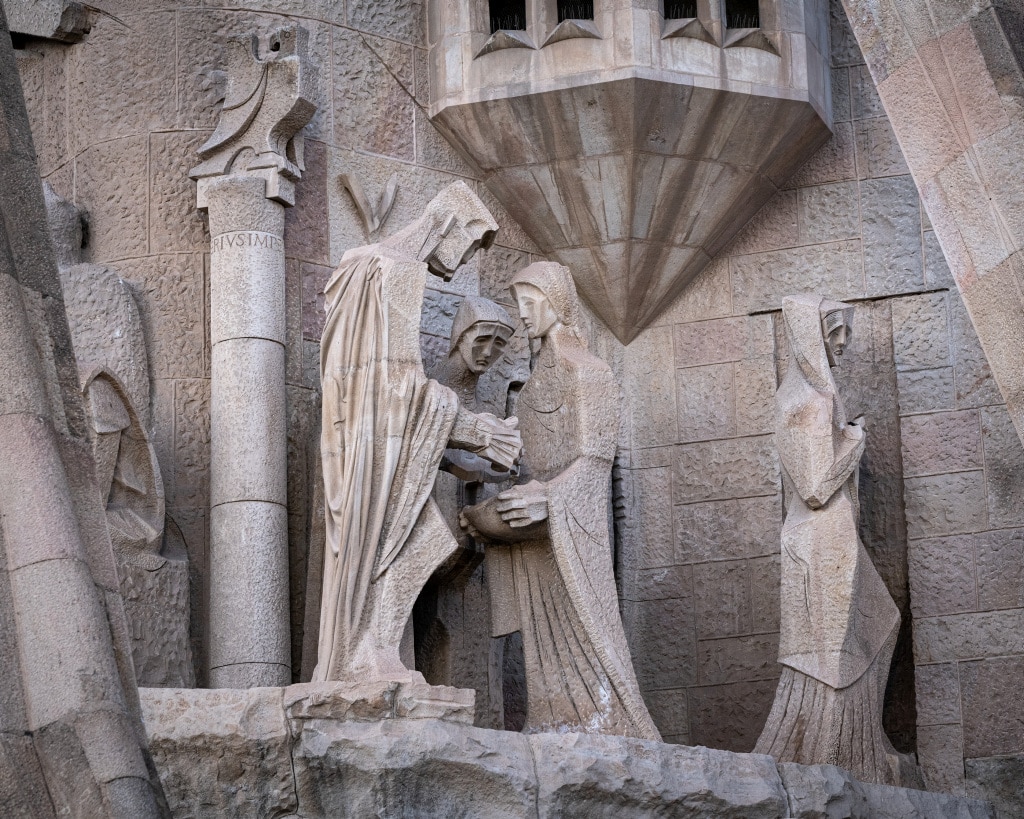
The governor washes his hands, while his wife Procula leaves because she believes they are condemning a just man. Between this sculpture group and the previous one, there is a column with a Roman eagle perched on top and the inscription “Tiberius, emperor of Rome”.
8. Jesus falls before the three Marys
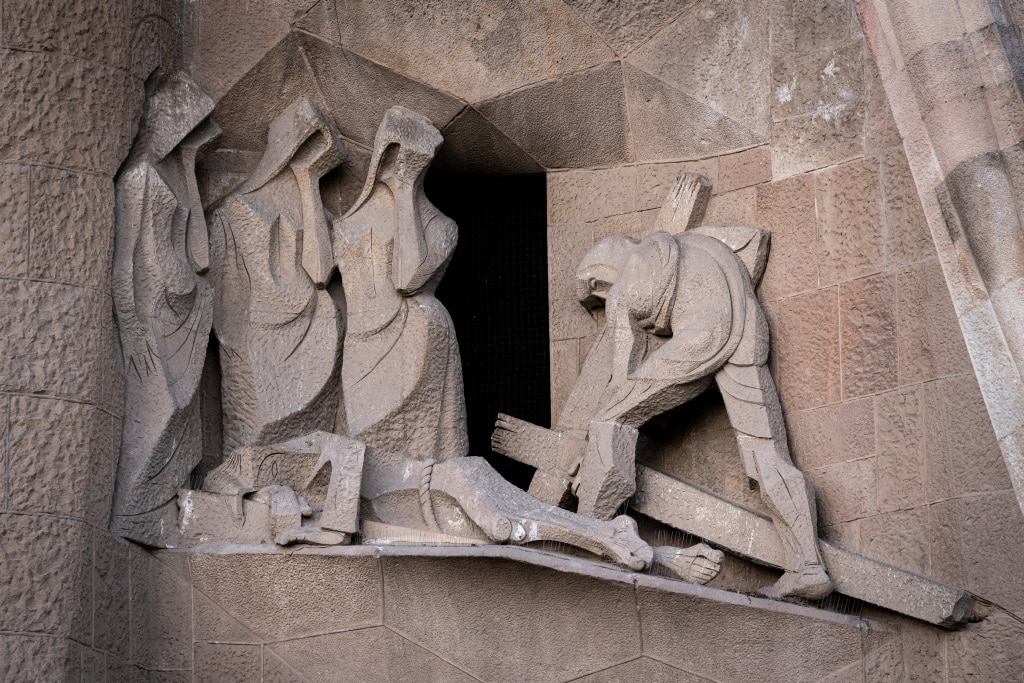
The three Marys (the Virgin Mary, Mary of Clopas and Mary Magdalene) cry the first time Jesus falls on the way to Calvary, and Simon of Cyrene helps him lift the cross.
9. Jesus consoles the women of Jerusalem
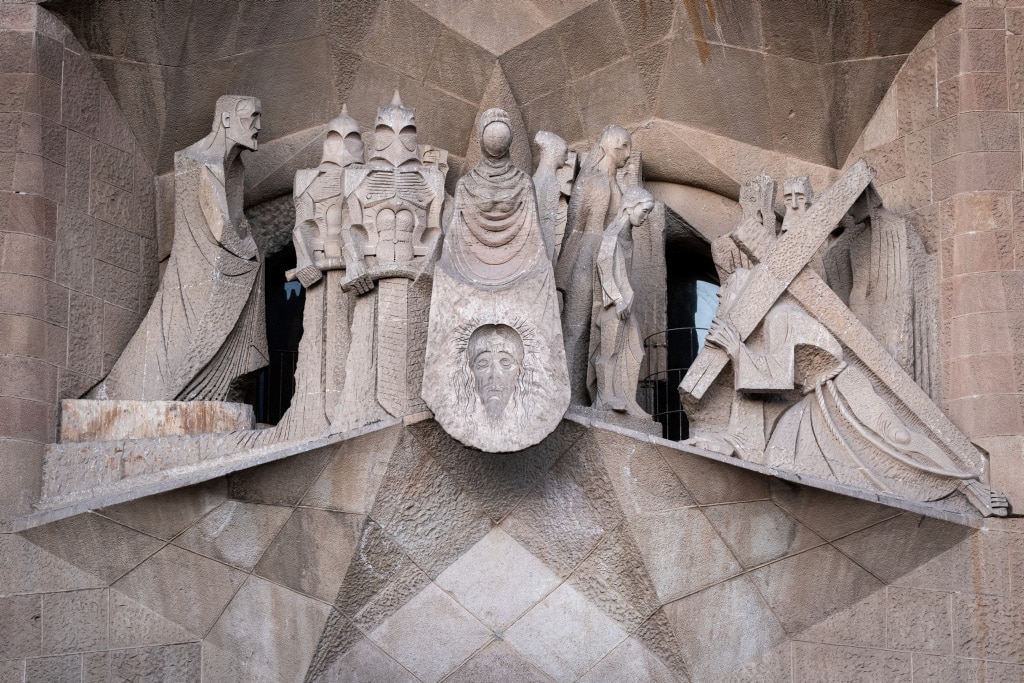
The central sculpture group on the middle level depicts the second time Jesus fell on the Via Crucis and his meeting with the women of Jerusalem. One of these women, Veronica, cleans blood from Jesus’ face, which leaves an imprint on the cloth. Carved in low relief, the effigy of Jesus seems to be looking right at the viewer, regardless of where they stand.
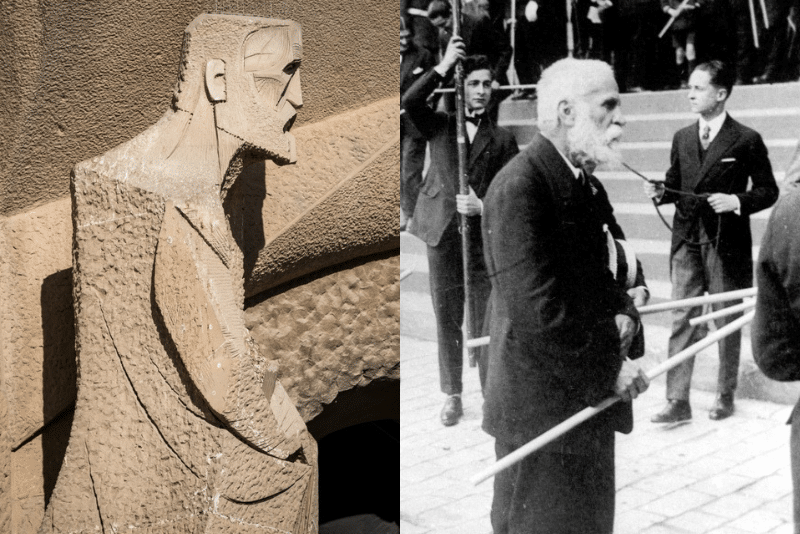
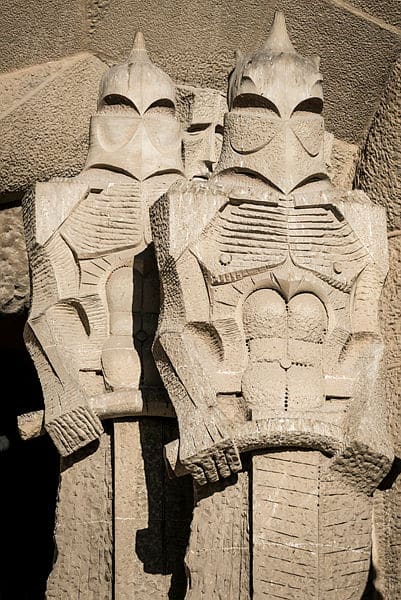
In this scene, Subirachs included two tributes to Antoni Gaudí. On the one hand, the figure of the Evangelist on the left side of the sculpture group reproduces the architect’s face from the Corpus Christi procession in Barcelona. On the other, he imitated the chimneys at Casa Milà in the soldiers helmets.
10. Longinus on a horse
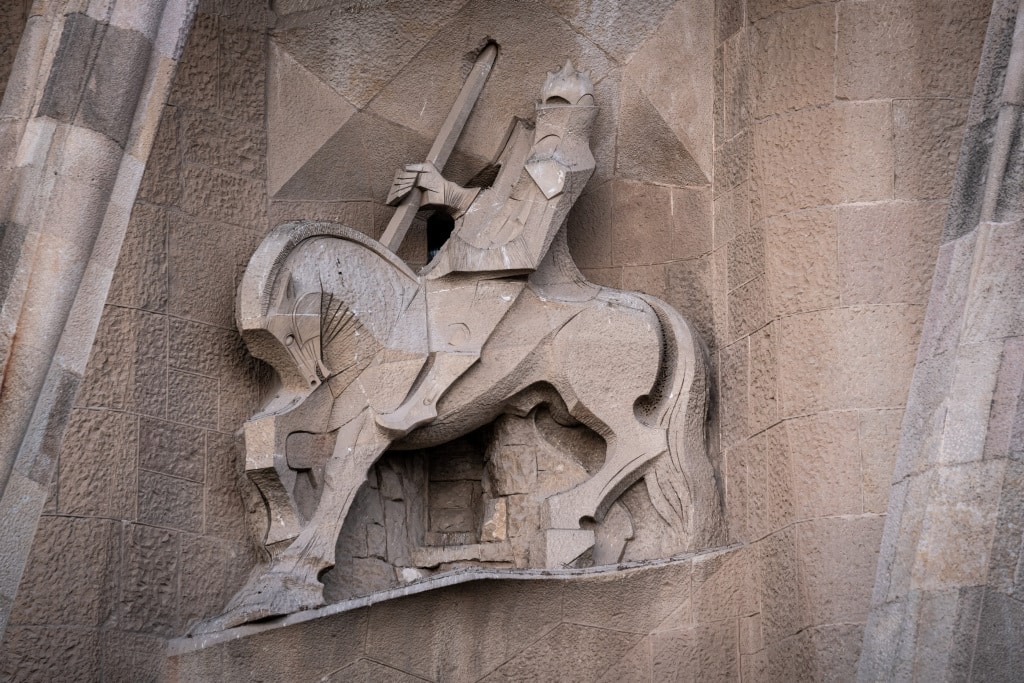
The soldier’s lance is piercing Jesus’ side on the cross. Afterwards, Longinus converted to Christianity and became a martyr of the Church.
11. Soldiers throwing dice to win Jesus tunic
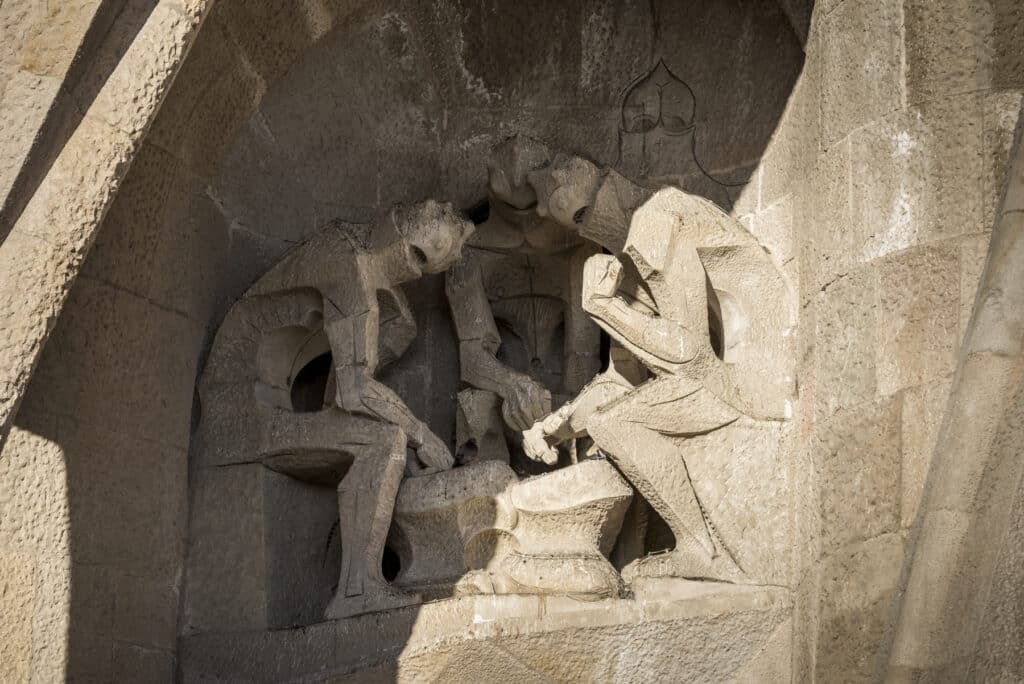
12. Crucifixion
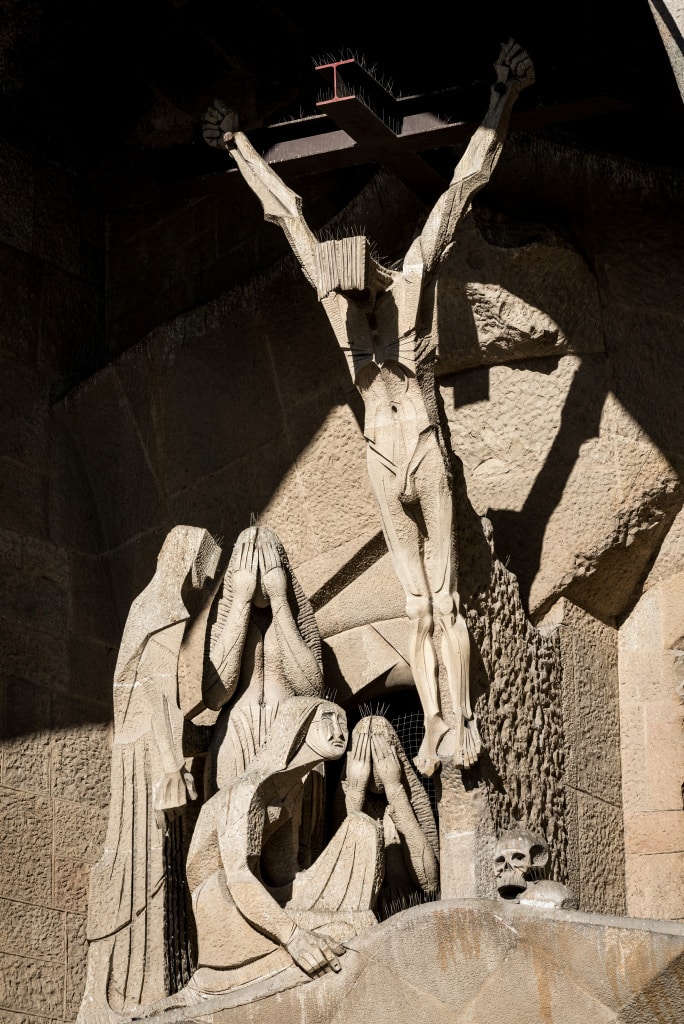
Jesus on the cross. At the Messiah’s feet, Mary Magdalene, kneeling; Mary of Clopas and the Virgin Mary with her face covered, consoled by Saint John. At the base of the cross, a skull symbolises death and the place Christ was crucified (Golgotha means skull in Aramaic), while an open tomb portends the Resurrection.
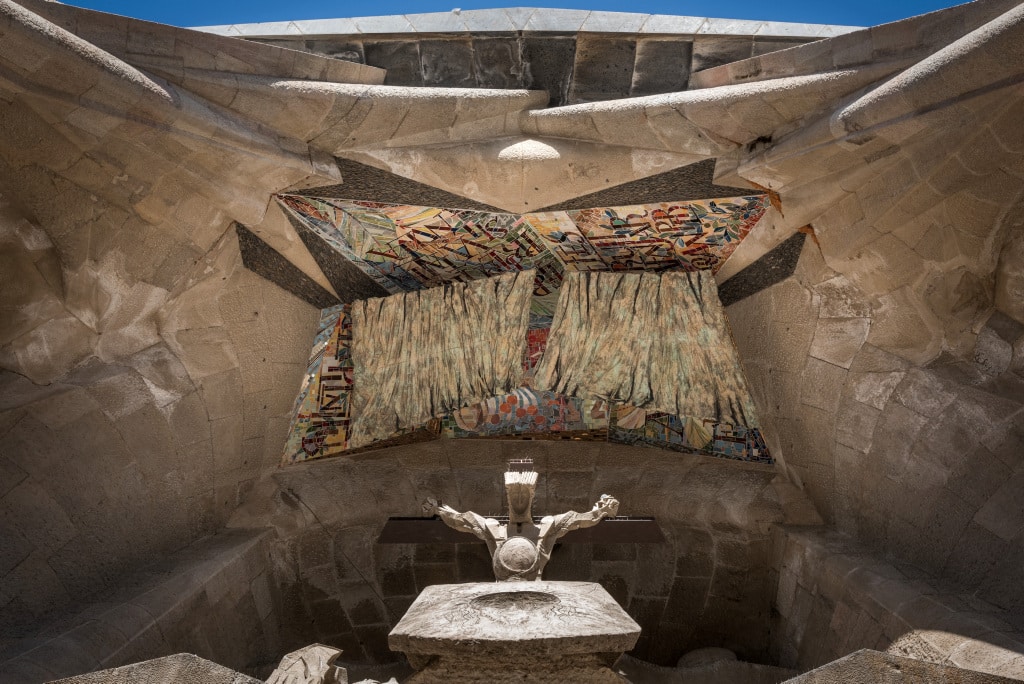
Above the group of the Crucifixion, like a baldachin, Subirachs placed bronze plaques to represent the veil at the temple of Jerusalem that, according to the Gospels, was torn in two when Jesus died.
13. Descent from the cross and the entombment
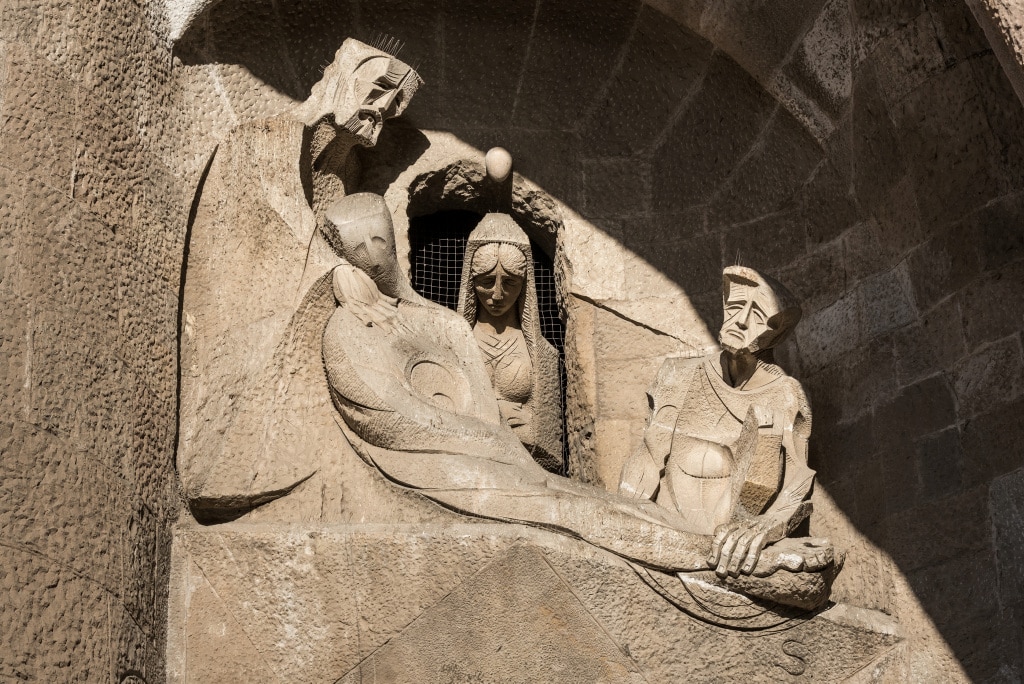
The final scene on the upper level of the lower narthex represents the burial of Jesus. Joseph of Arimathea and Nicodemus (two members of the Sanhedrin, a council of elders in Jerusalem) sadly lay the body of Christ in the tomb. Between them, on her knees looking defeated, the Virgin Mary.
Pediment: Resurrection and Ascension to Heaven
Above the lower narthex, on the pediment, Gaudí designed a gallery of hexagonal prisms (inscribed with the Latin phrase “Iesus Nazarenus, Rex Iudaeorum”, meaning “Jesus the Nazarene, King of the Jews”) supported at one end, on eighteen columns (evocative of bones) and at the other, on a wall adjacent to the towers. On this wall, Subirachs inscribed the names of the individuals sent by God who are walking towards the Resurrected Jesus: Biblical patriarchs on one side (starting with Adam and Eve) and the prophets on the other.
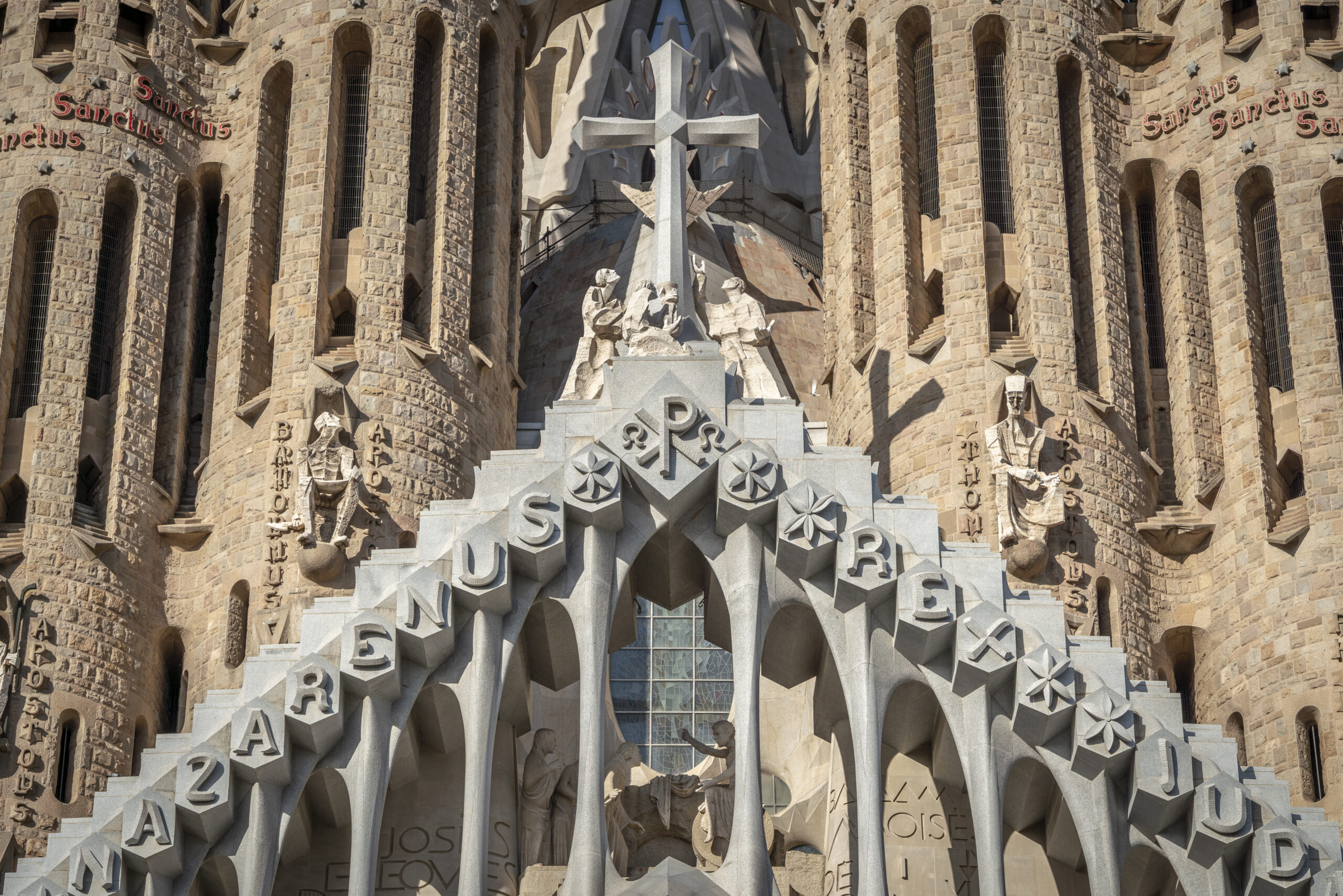
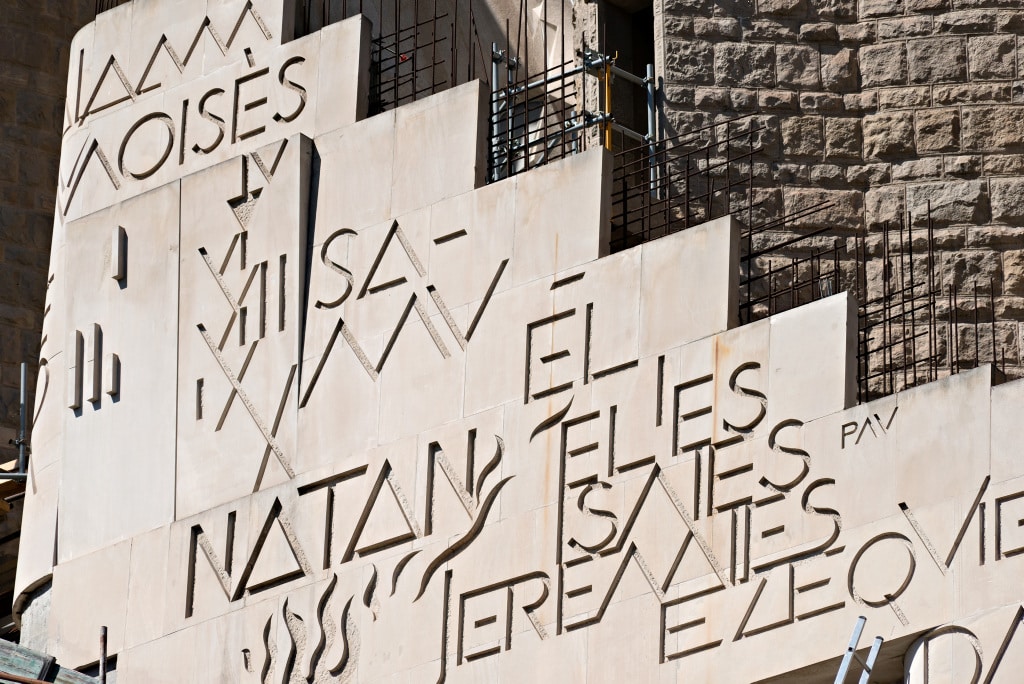
14. Quarry and garden
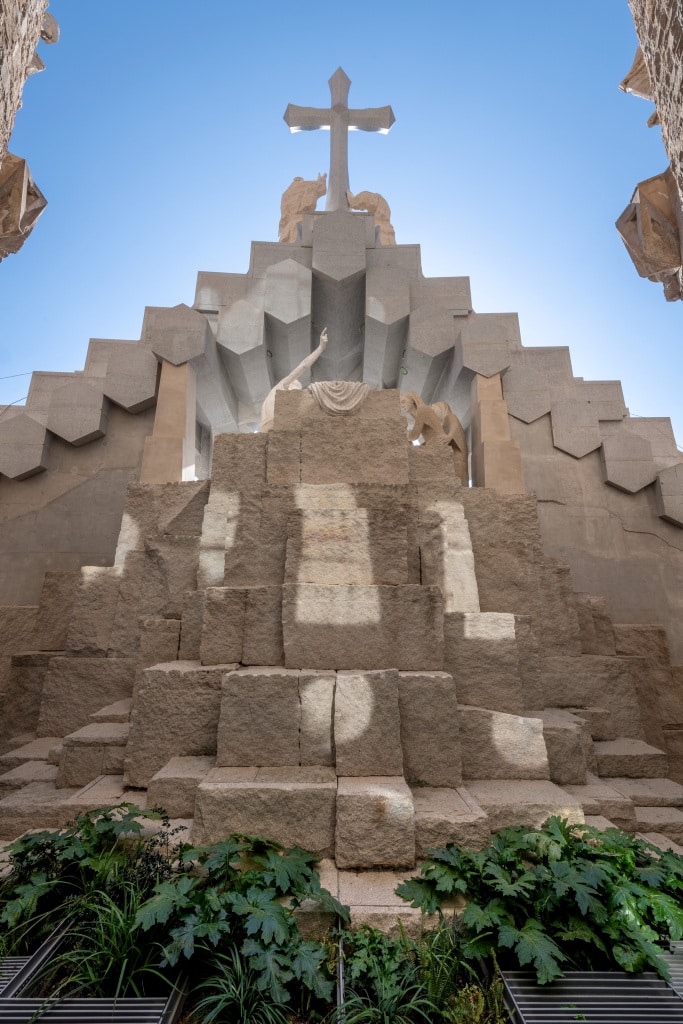
Just behind the sculpture group of the Empty Tomb and in front of the Window of the Resurrection, there is a garden reminiscent of the place where the tomb was dug. In this space of prayer and contemplation, Mediterranean species have been planted, symbolising life after death on the one hand and the typical vegetation of the area, according to the Gospels, on the other.
15. Empty Tomb
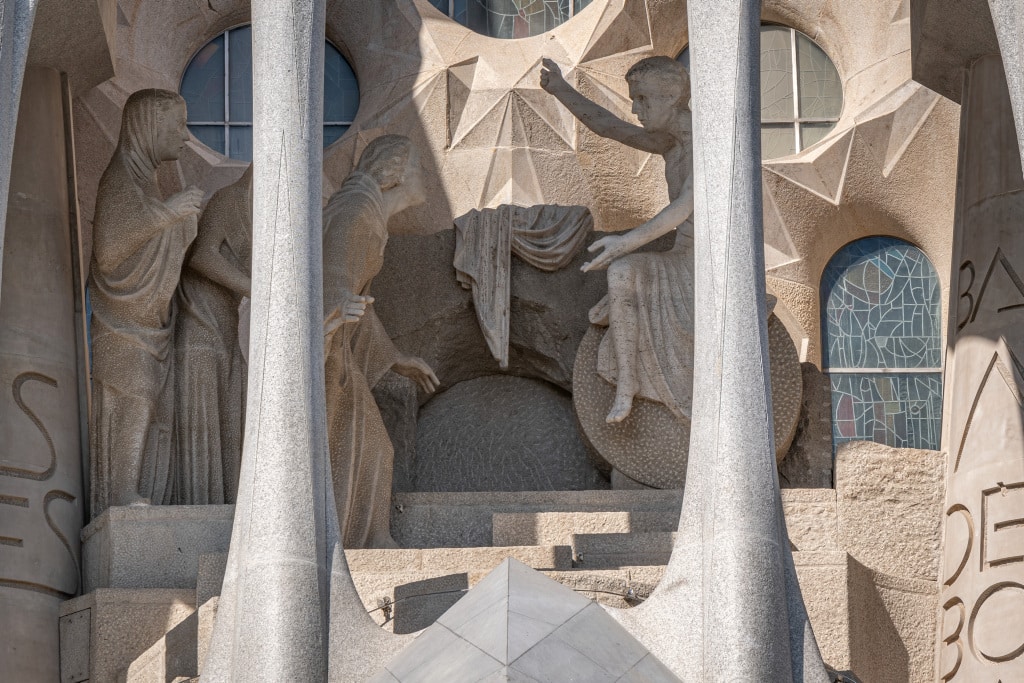
Between the two central columns in the pediment gallery, there is a sculpture group by sculptor Francesc Fajula. It shows an angel sitting on the round stone that covered the entrance to the tomb, announcing the resurrection to Mary Magdalene, Mary (mother of James) and Salome.
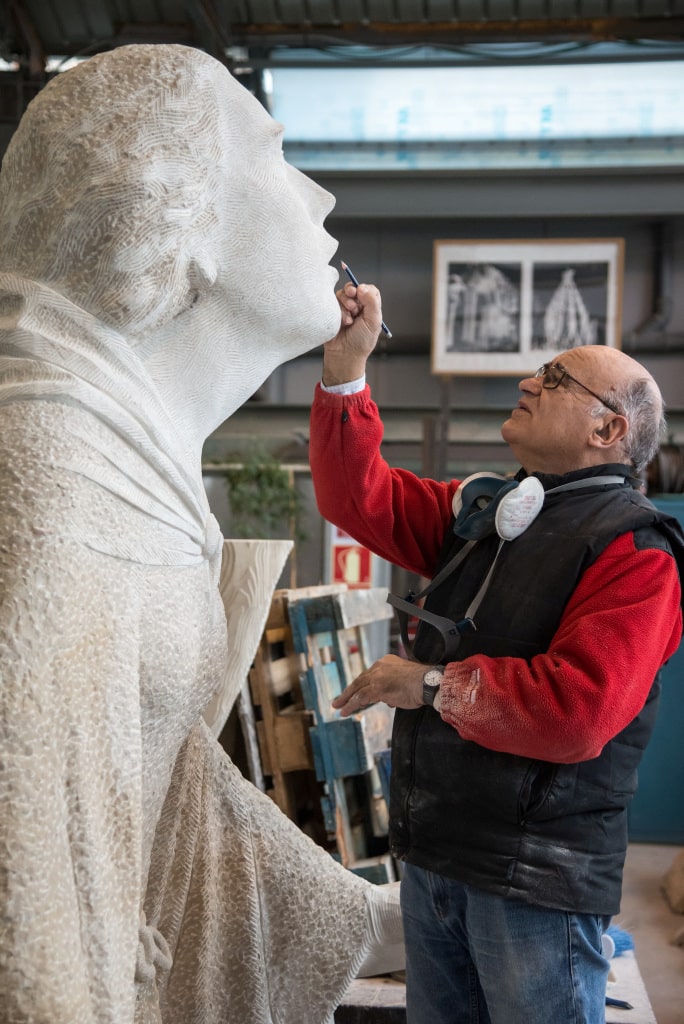
Francesc Fajula i Pellicer (Sant Joan de les Abadesses, 1945): architect, sculptor and PhD in Fine Arts and expert in heritage sites. He has worked with the Sagrada Família on several sculpted images, including the Crucifixion on the central altar baldachin, Saint Scholastica in the apse and the Empty Tomb.
16. The stained-glass window of the Resurrection
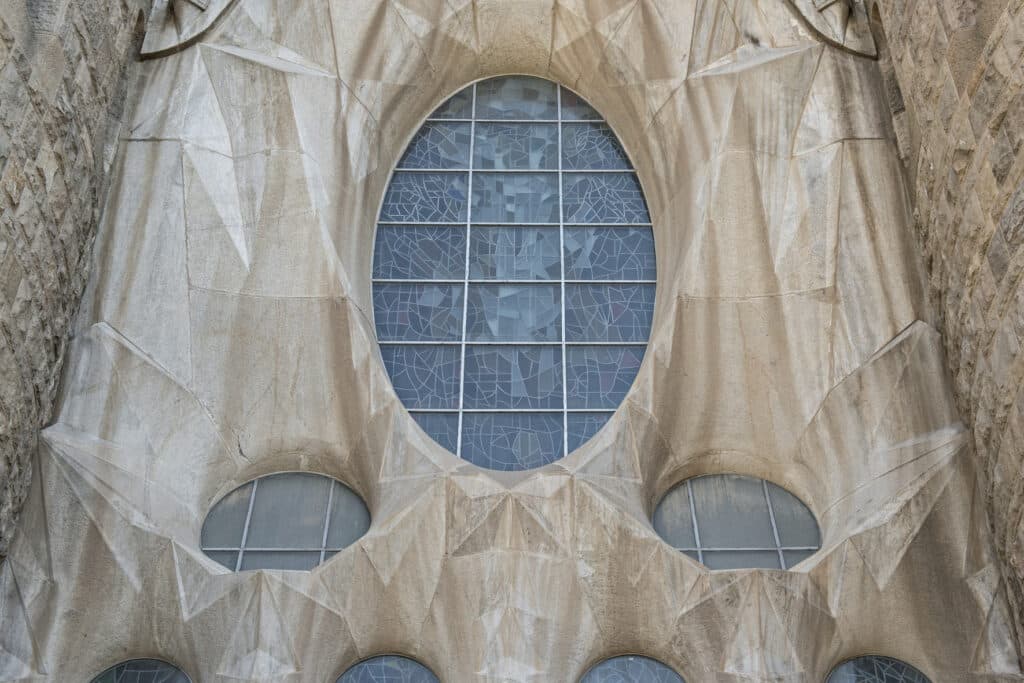
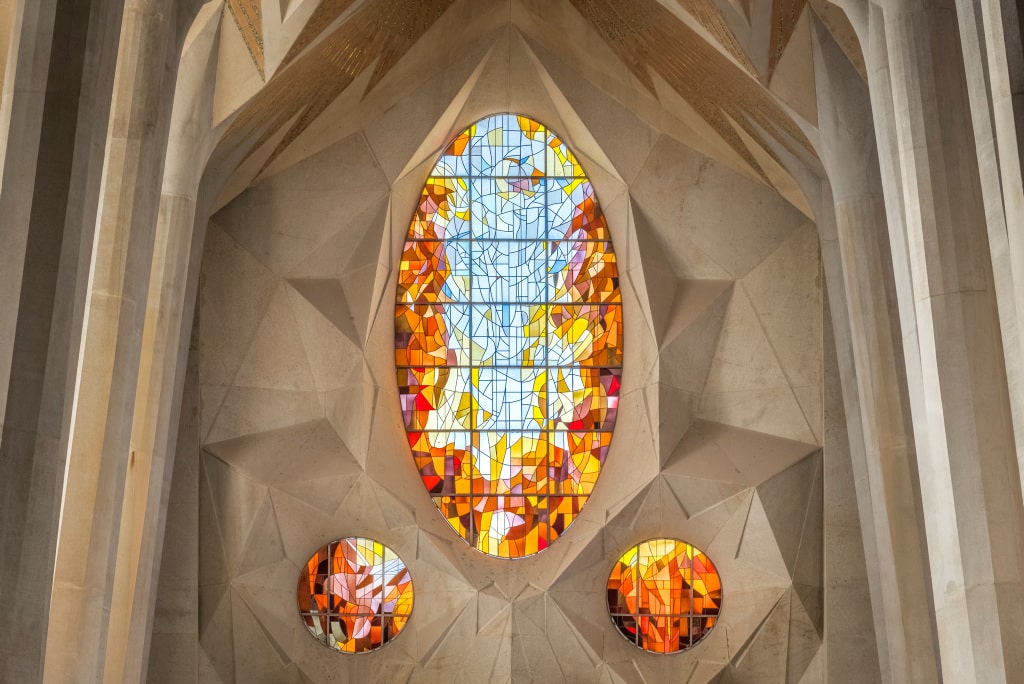
The open space in the Empty Tomb contrasts with the colourful stained-glass window by stained-glass artist Joan Vila-Grau.
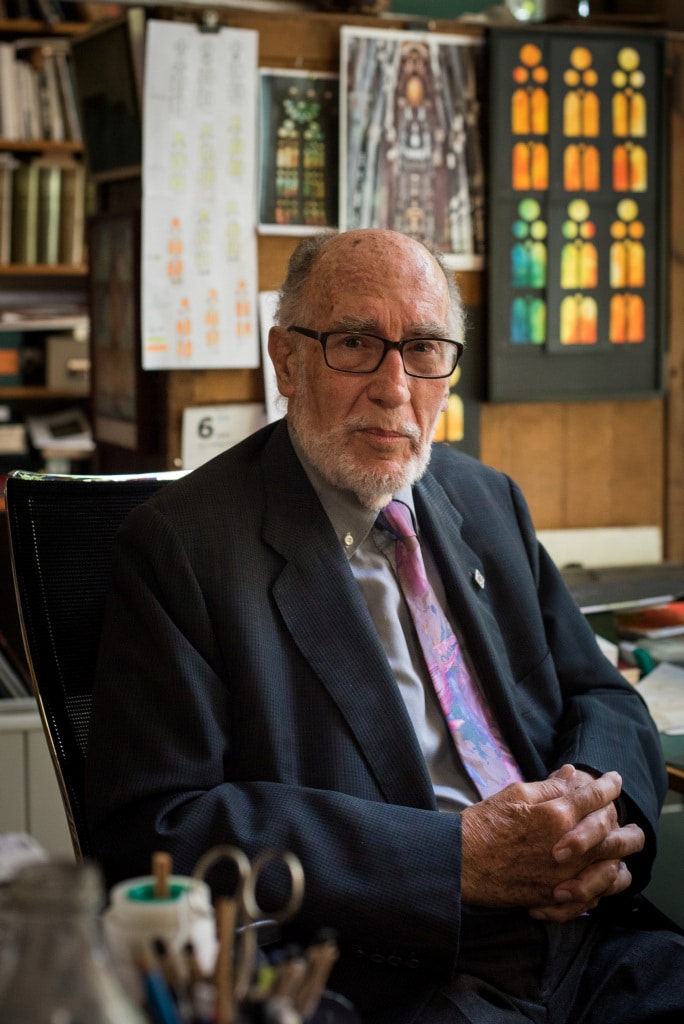
Joan Vila-Grau (Barcelona, 1932-2022): artist who devoted his professional life to painting, ceramics and stained-glass. Interested in the renewal of religious art, he specialised in the historical study of stained-glass windows in Catalonia and in creating contemporary windows. In 1999, he began work on the stained-glass windows for the naves at the Sagrada Família, which he worked on for over 20 years.
17. Cross and angels
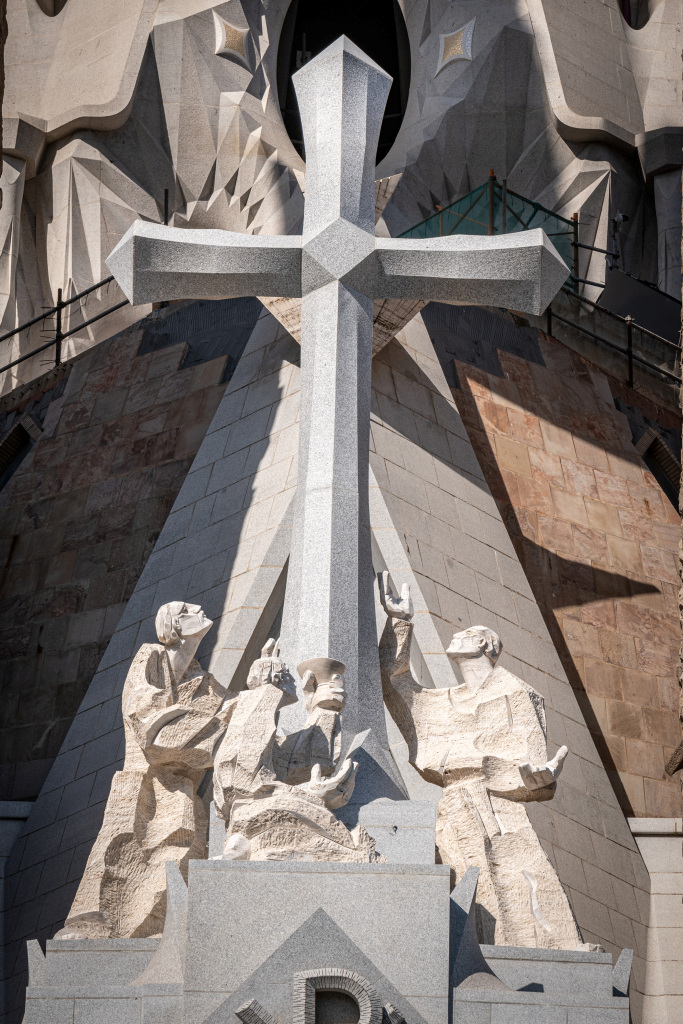
At the centre of the pediment, a 7.5 metre cross weighing 18 tonnes rises up, expressing victory over death, with three angels at its foot praising it. The pieces were sculpted in Italian travertine by sculptor Lau Feliu, and the shape of the group helps further elevate the façade towards the cross.
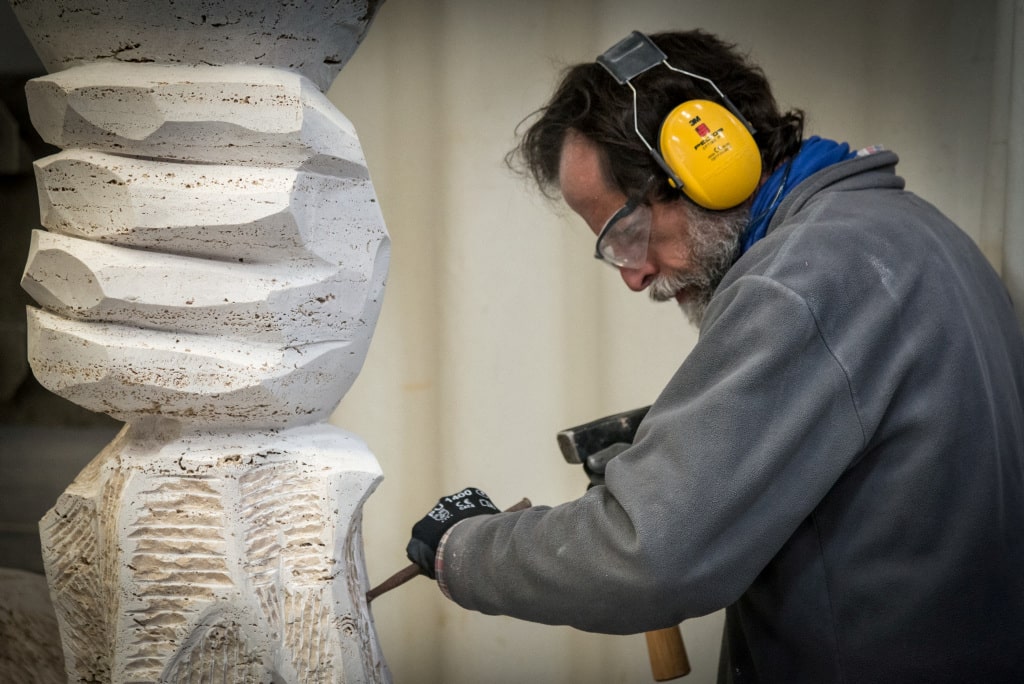
Lau Feliu i Maspons (Barcelona, 1957): Trained as a painter at Barcelona’s Escola Massana and in sculpture at the workshop of Cinto Casanovas, he combines these disciplines with jewellery, illustration and teaching art. In terms of sculpture, his religious work is particularly noteworthy. He has worked with the Sagrada Família on the sculpture group that stands with the cross on the cyma, the Lion of Judah, and The sacrificial Lamb of Isaac.
18. Holy Spirit
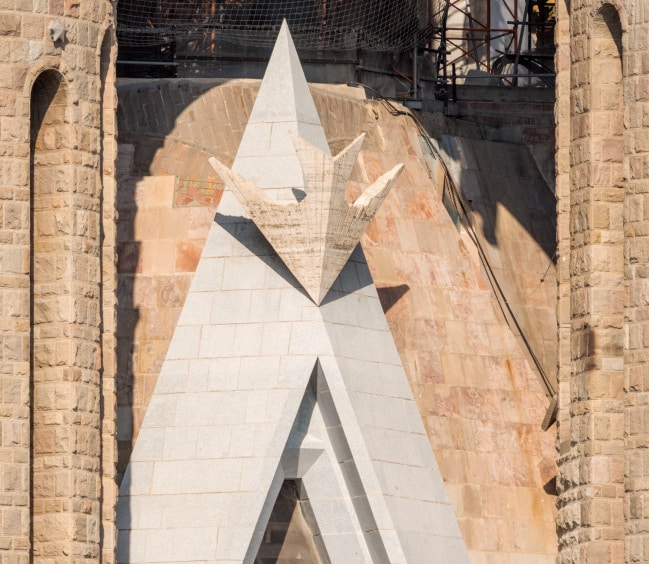
Above the narthex, at the top of the central window on the façade, we find the Holy Spirit, represented by a dove.
19. The ascension of Jesus

Finally, on the bridge that connects the two central bell towers, we discover the gilded bronze figure of the Ascension of Jesus, also by Subirachs.

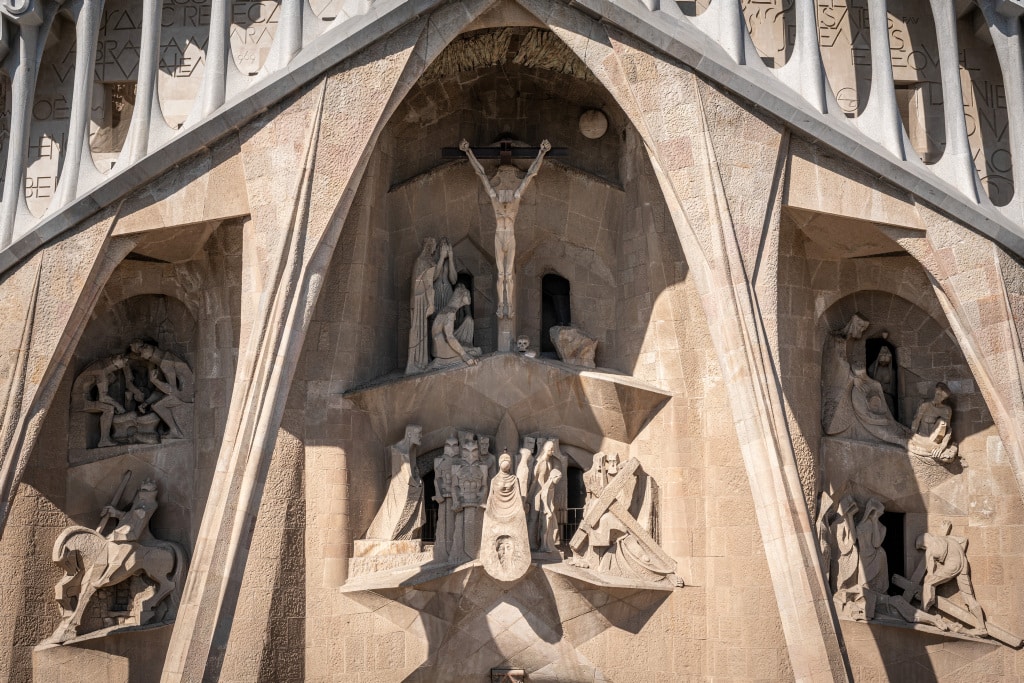
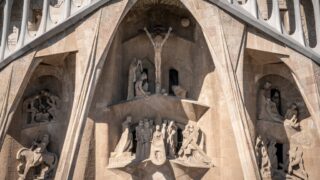
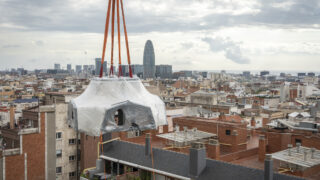
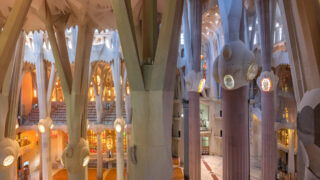
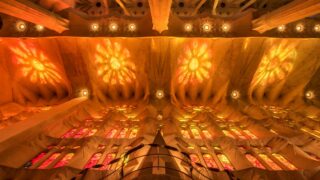
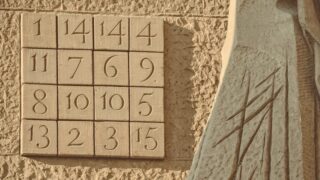
1 comment
Kevin Desoisa
I visited last week and had a wonderful emotional guided tour. Now am reading through the website and I am in awe. Words fail me.